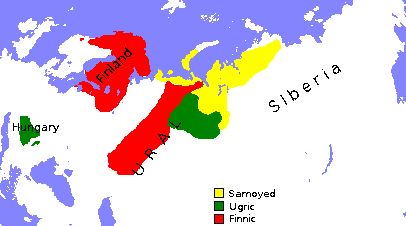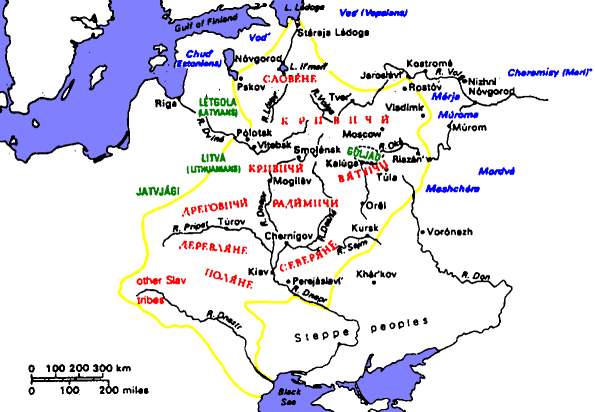Introduction
The Uralic languages constitute a language family of 39 languages spoken by approximately 25 million people. The name "Uralic" refers to the suggested original homeland of the Uralic family, which was often located in the vicinity of the Ural Mountains.
The healthiest Uralic languages in terms of the number of native speakers are Hungarian, Finnish, Estonian, Mari? and Udmurt.
Geographic distribution

Languages tree

Yellow = the area of continuous Slavic population after early expansion.
Uralic languages came early in contact with Slavic languages and
many Uralic languages (tribes) were assimilated.
On the map the following Uralic tribes are marked in blue:
Ves' (Vepsians), Vod (Votic), Mari, Merya, Muromian, and Meshcherian.
Language Family Tree
Uralic- Finnic (12 languages)
- Khantyic
- East Khanty
- Surgut Khanty
- Vach-Vasjugan
- Northern Khanty
- [kca] Kazym-Berezover-Suryskarer Khanty
- Obdorsk Khanty
- Southern Khanty
- East Khanty
- Mansic
- North-Central Mansi
- Central Mansi
- [mns] Northern Mansi
- Southern Mansi
- North-Central Mansi
- Mari
- [mhr] Eastern Mari
- [mrj] Western Mari
- Mordvin
- [myv] Erzya
- [mdf] Moksha
- Permian
- Komi
- [koi] Komi-Permyak
- Komi-Yazva
- [kpv] Komi-Zyrian
- [udm] Udmurt
- Komi
- Saami (11 languages)
- Samoyedic
- Enets-Nenets
- Enets
- [enf] Forest Enets
- [enh] Tundra Enets
- Nenets
- Forest Nenets
- [yrk] Tundra Nenets
- Enets
- Kamas-Selkup
- [xas] Kamas-Koibal
- [sel] Selkup
- [mtm] Mator-Taigi-Karagas
- [nio] Nganasan
- Enets-Nenets
- [hun] Hungarian